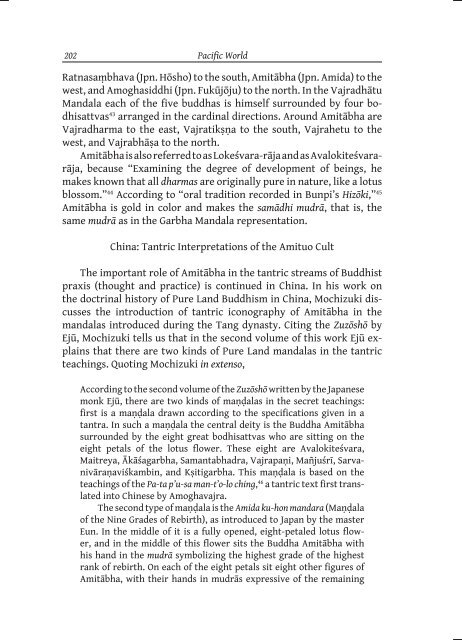The Shingon Subordinating Fire Offering for AmitÄbha, âAmida Kei ...
The Shingon Subordinating Fire Offering for AmitÄbha, âAmida Kei ...
The Shingon Subordinating Fire Offering for AmitÄbha, âAmida Kei ...
You also want an ePaper? Increase the reach of your titles
YUMPU automatically turns print PDFs into web optimized ePapers that Google loves.
202<br />
Pacific World<br />
Ratnasaṃbhava (Jpn. Hōsho) to the south, Amitābha (Jpn. Amida) to the<br />
west, and Amoghasiddhi (Jpn. Fukūjōju) to the north. In the Vajradhātu<br />
Mandala each of the five buddhas is himself surrounded by four bodhisattvas<br />
43 arranged in the cardinal directions. Around Amitābha are<br />
Vajradharma to the east, Vajratikṣṇa to the south, Vajrahetu to the<br />
west, and Vajrabhāṣa to the north.<br />
Amitābha is also referred to as Lokeśvara-rāja and as Avalokiteśvararāja,<br />
because “Examining the degree of development of beings, he<br />
makes known that all dharmas are originally pure in nature, like a lotus<br />
blossom.” 44 According to “oral tradition recorded in Bunpi’s Hizōki,” 45<br />
Amitābha is gold in color and makes the samādhi mudrā, that is, the<br />
same mudrā as in the Garbha Mandala representation.<br />
China: Tantric Interpretations of the Amituo Cult<br />
<strong>The</strong> important role of Amitābha in the tantric streams of Buddhist<br />
praxis (thought and practice) is continued in China. In his work on<br />
the doctrinal history of Pure Land Buddhism in China, Mochizuki discusses<br />
the introduction of tantric iconography of Amitābha in the<br />
mandalas introduced during the Tang dynasty. Citing the Zuzōshō by<br />
Ejū, Mochizuki tells us that in the second volume of this work Ejū explains<br />
that there are two kinds of Pure Land mandalas in the tantric<br />
teachings. Quoting Mochizuki in extenso,<br />
According to the second volume of the Zuzōshō written by the Japanese<br />
monk Ejū, there are two kinds of maṇḍalas in the secret teachings:<br />
first is a maṇḍala drawn according to the specifications given in a<br />
tantra. In such a maṇḍala the central deity is the Buddha Amitābha<br />
surrounded by the eight great bodhisattvas who are sitting on the<br />
eight petals of the lotus flower. <strong>The</strong>se eight are Avalokiteśvara,<br />
Maitreya, Ākāśagarbha, Samantabhadra, Vajrapaṇi, Mañjuśrī, Sarvanivāraṇaviśkambin,<br />
and Kṣitigarbha. This maṇḍala is based on the<br />
teachings of the Pa-ta p’u-sa man-t’o-lo ching, 46 a tantric text first translated<br />
into Chinese by Amoghavajra.<br />
<strong>The</strong> second type of maṇḍala is the Amida ku-hon mandara (Maṇḍala<br />
of the Nine Grades of Rebirth), as introduced to Japan by the master<br />
Eun. In the middle of it is a fully opened, eight-petaled lotus flower,<br />
and in the middle of this flower sits the Buddha Amitābha with<br />
his hand in the mudrā symbolizing the highest grade of the highest<br />
rank of rebirth. On each of the eight petals sit eight other figures of<br />
Amitābha, with their hands in mudrās expressive of the remaining
















